
|   |

|   |
Raja Rani Music Festival - Dr. Sunil Kothari e-mail: sunilkothari1933@gmail.com Photos: Arabinda Mahapatra January 29, 2013 After an interval of one day, the 3 day Raja Rani Music Festival commenced on 18th January with the back drop of Raja Rani temple. Odisha is indeed a city of exquisite temples. Constructed between the 10th and 11the century, Raja Rani is one of the finest architectural splendors made up of reddish sandstone, known as 'rajarania' stone. A best specimen of Kalinga architecture, it has elegant and lively female figures in amorous dalliance, engaged in various activities like holding children, looking in mirrors, removing ankle bells, playing with pet birds. One can see in the temple, guardians of eight directions viz., Indra, Agni, Nirriti, Varuna, Vayu, Kubera, Yama and Ishana. From the base of the temple one can find them around the porch, deul and the torana (arch). Currently the sanctum sanctorum has no deity for worship. But the archaeological department seems to be taking great care of the temple with excellent landscaping planned in a large space. The Odisha Tourism Department had transformed the entire area as per Mr. Ashok Kumar Tripathi's penchant for thousands of tiny blue bulbs, various lamp shades, decorative hangings, painted clay pots, flowers, the feedback system placed imaginatively with covering of black cloth in front of large 'uruli' (typical Keralite utensils) filled with water and flowers, and the entire square covered with green grass, the road leading to temple ablaze with artistic lighting, making the venue sufficiently attractive. This year a special rectangular platform covered with a canopy was erected manipulating digital copies of Raja Rani temple architecture, floral patterns, sculptures and design as borders for the platform. The sound system well under control, lighting as required by DD Television, with the result that performing artistes on stage can hardly see the large audience as the lighting literally blinds them. One possible solution could be light on the audience strategically placed, so the artistes can see audience. 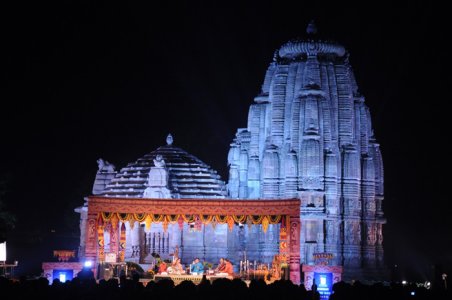 Raja Rani temple 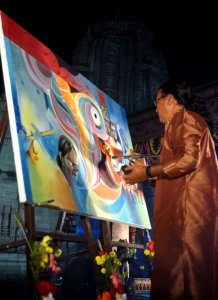 Baldev Maharath Legendary Shyamamani Devi, the eminent singer who has rendered inestimable contribution in the field of Odissi music since last six decades opened the festival with her amazing range of voice, even at an advanced age of 75 years! A pioneering singer in respect to Odissi, Chhanda, Champu, Janana, Bhajana etc., she was trained by Guru Singhari Shyamsundar Kar and Balakrishna Das. With her dulcet voice, she has dominated winning love of the public in the Odissi music scene. With inception of All India Radio in Cuttack, her voice reached every home in Odisha. All coveted honours have been received by her including Odisha Sangeet Natak Akademi award, Upendra Bhanja Award, Lifetime Achievement award from Chandigarh University, and felicitations by the Presidents of India for Odissi music. Of late, Odiya poetry has been engaging my attention a lot, as I am able to follow the meaning of the songs by poets like Banamali and Upendra Bhanja. The songs which are used by dancers for abhinaya have a lyrical, emotional and an attractive quality with typical musical charm of Odisha. 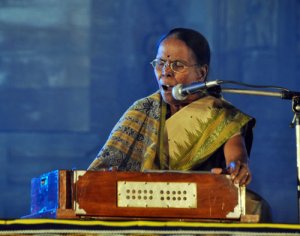
Shyamamani Devi
I had met her in November during Meera Das's festival at Cuttack and again at Kala Vikash Kendra's 60th anniversary program on 20th December. Many years ago I must have met her with Babulal Doshi, which she remembered. So very kind of her, I felt very humbled. Her transparent sincerity, self effacing nature and simplicity are very endearing. Another song, a chhanda 'Duti kara dhari, Hari boile Kishori, me puji hansithila gala to pasuri' of poet Abhimanyu was one more delightful gem she offered. The maiden, Kishori, holding the hand of Duti, the confidante, speaks of worshipping the Lord, and describes the mesmerizing effect of his flute. Shyammani concluded her recital with Gita Govinda ashtapadi 'Pashyati dishi dishi' the sakhi telling Krishna of the plight of Radha, as a vasaksajja, looking for him in all directions. She rendered it in Bhairavi with lot of feeling. Such artistes still uphold a rich legacy of musical tradition and thereby assure us of its timeless quality.
From Chennai, the mandolin maestro U. Srinivas, was invited to render classical Carnatic music. As a child prodigy he had displayed highly complex music combined with his own style of modified Western mandolin techniques, producing a dazzling sound that 'straddles jazz and sophisticated Indian classical music.' When he was barely 13, he took Western world by storm, appearing at the 1983 Jazzfest in West Berlin, mixing Indian classical music with jazz sounds. His biographical notes include his starring at 1992 Barcelona Olympics Music Festival. He has modified the Western mandolin and adapted it to the needs of the highly complex Carnatic music of the South with staggering range of musical effects at his fingertips. He possesses a 'soaring melodic imagination' the proof of which he gave during his enchanting recital. He began with Muthuswami Dikshitar's 'Vathapi Ganapathim bhajeham' in Hamsadhwani in a devotional mood, followed by Thyagaraja's kriti 'Endaro Mahanubhavulu' with feeling of humility a devotee speaks as reflected in Thyagaraja's eternal kriti. His playing of Narasimha Mehta's Gujarati bhajan 'Vaishnava jana to tene re kahiye' was received by the audience with applause. A Sai bhajan in Revati raga and tishra nadai was equally moving. He was accompanied by his brother Rajesh, who is another brilliant mandolin player and on mridangam by K. Murugabhoopathi. Second day The evening began with group Mardala playing under supervision of that great percussionist Guru Banamali Maharana. Since childhood, Banamali had dawn inspiration from Mohan Sundar Dev Goswamy and his theatre group Rasa Leela to play dholak and khol. He was inducted into the Odiya theatre Annapurna A group and studied mardala and tabla under Kshetra Mohan Kar and Singhari Shyam Sundar Kar. It is to the credit of Banamali that he systemized and formulated the Odissi style of mardala. Starting as an accompanist in Odissi Dance Department in Utkal Sangeet Mahavidyalaya, he became the Head, Department of Mardala, until his retirement in 1999. He organized the curriculum of mardala making it a seven year course. He has accompanied all the leading lights of Odissi dancers and singers. Banamali Maharana's training has been extensive. A large number of present mardala players have been trained by him, including (late) Guru Gangadhar Pradhan, Dhaneswar Swain, Niranjan Patra, Satchidanand Das, Kalindi Charan Parida, Jagannath Kuanwar, Bijay Kumar Barik and others. A brilliant artist he has been honored by Central and Odisha Sangeet Natak Akademi and is held in much respect by all in Odisha and nationally.
The group consisting of some of the artistes mentioned above performed mainly two talas, Jhampa (10 beats) and Aditala (16 beats) used for various aspects such as Janana, Gadi, Khandi, Arasa, Vaunri, Mana and Jati. The command over the tala and laya and consistent, uniform masterly playing by the percussionists revealed the rich variety of mardala playing. Rare are such occasions when we get an opportunity to acquaint ourselves with such a rich treasure trove. One felt privileged to share it. 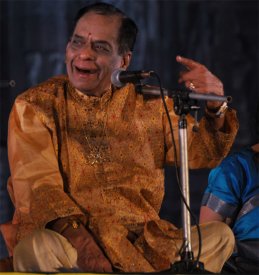 M.
Balamuralikrishna
In spite of bad cold and cough, he managed to rise above physical handicap and he performed with a booming voice surprising one and all. He rendered a prayer composed by himself in praise of Goddess Bhubaneswari, as he was performing in Bhubaneswar. His own composition of raga like Kantamani was another offering. One more composition was Samajavaragamana and a Thyagaraja kriti in Hindolam raga followed by Lavangi raga of four notes only, the composition 'Omkara karini.' He also spontaneously rendered a Gita Govinda ashatapdi 'Tava virahe Krishna Radhika' emoting Radha's pain at her separation from Lord Krishna. A surprise accompaniment was the whistle artist Eelapata Sivaprasad who accompanied him with fantastic fidelity, recreating the notes perfectly winning 'sabash' praise from the maestro. In the beginning I wondered who was playing the flute so melodiously, and to my surprise saw him whistling with great felicity. As it were, there were several birds in the green surroundings chirping and singing melodiously. The other accompanists lent support to the maestro with their customary finesse. Balamurali concluded with a thillana in Kathanakuthuhala raga made so popular by senior Bharatanatyam dancers performing to it. It was sheer bliss to listen to it. Having regaled the audience with such rich fare no wonder the maestro received a standing ovation. Third day All good things have to come to an end, and so did Raja Rani Music Festival on the 20th January evening. It began with the rendering of Odissi music in its various ramifications by Ram Hari Das, who has been on the scene highlighting the special features of Odissi music. Why people from Odisha want a special recognition for Odissi music as a classical form remains an enigma for some of us. It is a regional but a classical musical form, rich in its canvas and scope. Though it has not, it may seem, received recognition as Odissi dance has, its potential is universally accepted. Rama Hari Das is currently Head of Music Dept at Utkal University of Culture and also looks after Guru Kelucharan Mohapatra Odissi Research Centre, besides giving vocal recitals, composing music and teaching. A versatile musician, he has earned a reputation which he deserves as a leading Odissi musician. He has been honoured by the Central Sangeet Natak Akademi award besides various honours. Systematically dividing his recital in 6 sections he presented in Raganga style Prabandha Lokanatha Pattanaik's composition 'Kare dekhau teja re khanajan nayana' highlighting in Sankarabharanam raga and ek tali, the raga element replete with bhava, emotion of the composition, followed by Panchatala Prabandha consisting of Ekatali, Khemta, Tripata, Adatali and Pahapata in raga Shuddha Basanta to the lyric 'Mita asila basant' composed by Hari Priya Devi. That Odissi music has various aspects like Bhavanga style was demonstrated in Prabandha 'Mohane deli chahin, ago priya sahim,' a composition of Banamali (recently performed by Sangeeta Das at Mukteswar Dance Festival) in raga Kiravani in tala Yati. The Natyanga style saw a composition of Gopalakrishna in raga Khamaj and tala Ekatali, in rendering of Prabandha 'Sanginee re, rasa rangini re.' Without rendering of ashtapadi from Jaydeva's Gita Govinda, no Odissi music recital is complete. Therefore Ram Hari Das explained its importance in raga shuddha deshi and in tala ekatali. I have happy memories of Guru Kelucharan Mohapatra's choreography of the prabandha 'Sakhi he keshi mathanamudaram'. He concluded the recital with Chhanda from Bichitra Ramayana 'Aha dhanurdhara birabara', an example of Adhruva Panchali Prabandha, a composition by Biswanath Khunita. It had the feeling of divine Lord Rama who wields the bow. The contribution of Rama Hari Das indeed is of great importance. One looks forward to the next generation of vocalists to carry on this legacy. 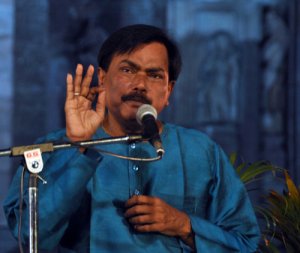 Ram Hari Das 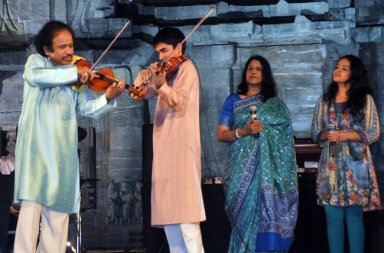 L. Subramaniam & group The finale for which a large turnout of audience was seen was on account of the celebrated violinist L. Subramaniam, his wife Kavita Krishnamurty, son Ambi, daughter Bindu and a large contingent of orchestra with guitar, keyboard, mridanga, and morsing. In her melodious voice, Kavita rendered Tulasidas's composition 'Sri Ramchandra kripalu bhajamana' setting the mood and transporting the audience to the musical world she created of the bhajan and the melody. She followed it with Om namah Shivaya refrain and song 'tin shabda me shrishti sari samaya' in raga Mohanam. The third song practically all knew and hummed was Meera bhajan 'Jo tum todo piya main nahi todun re, tori prit todi Krishna kaun sang jodun?' She is a brilliant singer and even in higher pitch can maintain wonderful balance. Dr. L. Subramaniam is another musician, a genius who has earned a reputation for performing, recording Carnatic classical music, Western classical music, both orchestral and non-orchestral. He has also composed for and conducted major orchestras and collaborated with wide range of some of the greatest musicians from different genres of music, including jazz, occidental, jugalbandis with North Indian musicians and taking world music with global fusion. On this evening he chose to present fusion music from his latest album titled 'Restless.' The command with which he played violin with extraordinary speed wielding the bow, his young vastly gifted son Ambi, matching the prowess of his illustrious father, took away the breath of the audience, in particular, those who listened to them for the first time and watched their skill. L. Subramaniam has created and composed a raga with aspects of Carnatic ragam and tanam, also close to Bhairavi, orchestrating it in imaginative manner, making it participatory, with Kavita's rendering of most popular rendering of 'Babul mora nahira chhuto hi jay', daughter Bindu rendering alap (unfortunately it was drowned). Ambi and others joining L. Subramaniam was extraordinary and won standing ovation of the overwhelmed audience. Even when a few die hard classist aficionados wanted him to perform classical Carnatic fare, the mood was celebratory and brought the Raja Rani Music Festival to a resounding success. For long the audience hovered around not wanting to leave the magical surroundings and ambience generated by the artistes. With three major dance festivals Konark, Dhauli-Kalinga and Mukteswar, Raja Rani as music festival was like cherry on the cake. One thanked Odisha Tourism department, the chief architect of the festivals, the indefatigable Mr. Ashok Kumar Tripathy and wonderful team of workers, including the two comperes Sadhna Srivastav and young E. Srinibas Ghatuary, who with his absolutely charming, poetic, compering in Odiya brought a lively element when announcing and filling the gaps when musicians were arriving for performances. In one corner, as usual Baladev Maharath, the versatile painter created visuals on a canvas which fascinated audiences. It was a memorable week full of dance and music, indeed highly enjoyable.  Dr. Sunil Kothari is a dance historian, scholar, author and a renowned dance critic. He is Vice President of World Dance Alliance Asia Pacific India chapter, based in New Delhi. He is honored by the President of India with Padma Shri, Sangeet Natak Akademi award and Senior Critic Award from Dance Critics Association, NYC. He is a regular contributor to www.narthaki.com, the roving critic for monthly magazine Sruti and is a contributing editor of Nartanam for the past 12 years. Post your comments Pl provide your name and email id along with your comment. All appropriate comments posted with name and email id in the blog will also be featured in the site. |